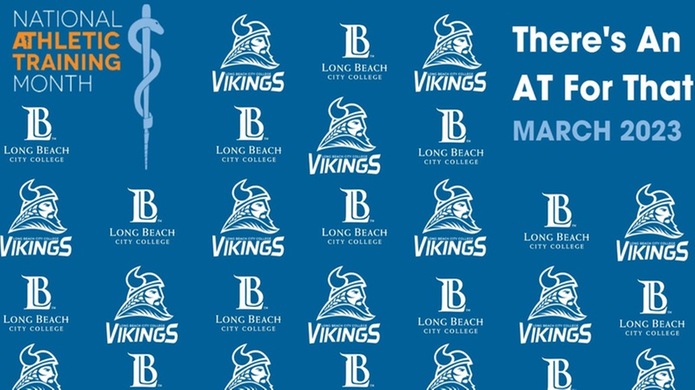
Did you know that National Athletic Training Month is also honored in the same month as Women's History Month? The timing is not a coincidence! Both groups have been trailblazers who inspire with their intelligence, grit, ambition, kindness, and humor. They are multi-tasking powerhouses holding up the atmosphere while pursuing their degrees, furthering their careers, and working to provide for and care for our Vikings families. That cannot be a coincidence, as both groups have worked tirelessly to advance equity in pay, representation, and acclaim in the workforce.
Long Beach City College would like to honor and recognize the frontline workers helping to keep our Vikings family safe - our Certified Athletic Trainers.
During the March, Athletic Trainers across America received recognition for their commitment to helping student-athletes prevent injuries, stay healthy and active, and, most recently, leading the way with establishing COVID-19 pandemic protocols. As healthcare professionals, Athletic Trainers are highly educated and dedicated to the job. Athletic Trainers work in many places, including high schools, two and four-year colleges/universities, fire departments, corporations, industries & manufacturing (Amazon, L3 Communications), professional sports, the military, performing arts, clinics, fitness centers, hospitals, and physician offices.
LBCC salutes our Certified Atheltic Training Staff Mary Aja, Meghanrose Beckman, Randall Beckman, Gissell Gutierrez, Jesus Tinoco, and Cade Deyner, our CSULB Athletic Training Interns, Long Beach Unified and Long Beach City College volunteers.
Part I – Athletic Training – What is that?
A two-part series introducing Athletic Training, a challenging and rewarding profession
1. What exactly is Athletic Training?
- The profession encompasses the prevention, examination, diagnosis, treatment, and rehabilitation of urgent, acute, or chronic injuries, and medical conditions. The American Medical Association, Health Resources Services Administration, and the Department of Health and Human Services recognize Athletic Training as an allied healthcare profession.
2. What educational steps are required to become a certified athletic trainer?
- The athletic training degree moved from a Bachelor's in Athletic Training to a graduate program in 2022. Currently, the degree is a Master of Science in Athletic Training.
- Prerequisite courses required for application include:
-
- Human Anatomy & Physiology, General Psychology, Physics, Chemistry, Biology, Biomechanics, Exercise Physiology, Nutrition, Prevention & Care of Athletic Injuries, and Statistics
3. How many Athletic Trainers does Long Beach City College have?
- The National Athletic Training Association Guidelines (NATA) recommends 50 student-athletes to every 1 Athletic Trainer. Long Beach City College employs two full-time Certified Athletic Trainers, and one part-time Certified Athletic Trainer and serves 19 sports programs including 500+ student-athletes annually.
- LBCC's current ratio is 204 Student-Athletes to every 1 Athletic Trainer, four times the NATA ratio.
- The California Community College Athletic Association governs LBCC Athletics. The current CCCAA standard is 114 student-athletes for every 1 Athletic Trainer, so we are booked, busy, and hoping to hire help ASAP!
4. What are some misconceptions about being an athletic trainer?
- Athletic trainers are personal trainers or fitness coaches.
- Athletic trainers only use ice and tape to treat athletic injuries
5. What do a typical day's tasks include?
- Meetings with the Athletic Director and coaches. Communicating with physicians and other health care partners discussing student-athletes health care/rehabilitation plans. Medical insurance claim documentation. Scheduling doctor's appointments for student-athletes. Maintenance and updating the electronic medical health records platform. Designing custom rehabilitation programs. Strategic planning for maintenance and upgrading equipment.
- Clinic Hours – Implementation and supervision of rehabilitation and treatment programs. Preparation for practices and games. Training and supervision of student athletic training students.
- Attend practices and games – Set up the venue with drinking water, cups, injury ice, and emergency response equipment (AED, splints, crutches, etc.)
- Attend to visiting student-athletes as needed.
- Implement the specific Emergency Action Plan (EAP) for the venue and review it with the EAP response team.
6. What part of the athletic training field do you think people would find the most surprising?
- Pay – The national average in colleges & universities is $53,00, which can be a 10-12 month assignment. The average wage in California - is $62,000.
- To put the Athletic Training wage into perspective – The average In-N-Out manager makes $57,000/year while the average professional football player makes $75,000.
Stay tuned for part 2 – Interview with Long Beach City College Certified Athletic Training staff!
For more information on National Athletic Training Month, please visit: https://www.nata.org/advocacy/public-relations/national-athletic-training-month.
#NATM2023 #TheresAnATForThat #AT4Me #LBCCVIKINGS #LONGBEACH #ATCATLBCC